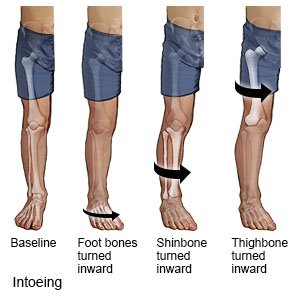Intoeing
Medically reviewed by Drugs.com. Last updated on Aug 4, 2025.
Intoeing means your child walks with his or her toes pointed in. It is also called pigeon toe. One or both of your child's feet may be affected. Your child may start to show signs of intoeing any time up to about 8 years of age. Intoeing is common in children. It can be mild or severe and often goes away without treatment.
 |
DISCHARGE INSTRUCTIONS:
Contact your child's healthcare provider if:
- Your child develops a limp when he or she walks.
- Your child has leg pain or swelling.
- You have questions or concerns about your child's condition or care.
Follow up with your child's healthcare provider as directed:
Your child may need more tests to see if the intoeing is getting better over time. Tests may also show if your child is developing new problems. Write down your questions so you remember to ask them during your visits.
Manage your child's intoeing:
- Do not use any corrective devices unless directed. Shoe inserts and cables do not help fix the problem. They can also make it hard for your child to play and walk.
- Stretch your infant's foot as directed. You may be shown stretching exercises for your infant's feet. You may need to do the stretches a few times each day.
- Ask about your child's activities. Ask if your older child can do activities such as sports. He or she may need to wait if intoeing causes him or her to trip.
© Copyright Merative 2025 Information is for End User's use only and may not be sold, redistributed or otherwise used for commercial purposes.
The above information is an educational aid only. It is not intended as medical advice for individual conditions or treatments. Talk to your doctor, nurse or pharmacist before following any medical regimen to see if it is safe and effective for you.
Further information
Always consult your healthcare provider to ensure the information displayed on this page applies to your personal circumstances.
